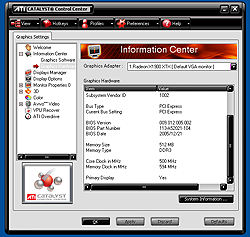System Setup and Notes
ATI sampling stronger than I can remember, pieces of X1900 XTX, X1900 XT and X1900 Crossfire have been in HEXUS hands for nearly two weeks. That's almost long enough to have Eurozone reviewers not called Dave Baumman wonder whether ATI was an anagram of NVIDIA. Almost.This review, for those who've forgotten the article title, concerns itself with the XTX and XT variations. We'll do Crossfire soon, hold tight for that. Doing away with the Platinum Edition moniker for the first two-tier release of R580 - although don't bet on that moniker being dead and buried for ever, despite what you might read elsewhere - XTX is a 25MHz GPU and memory clock bump over XT.
With XT retail boards using the same BJ11 DRAMs and R580 GPU, at the same core voltage no less, XTX is a slightly curious SKU. ATI is asking for a fairly large leap of faith that XTX is something special on top of XT in order to extract the other $100 it wants for the 2nd X in the name. We're not convinced at the time of writing. Either that or all the XT retail boards we've seen are XTX bins with a different BIOS.
"But we ain't binnin' for XTX!", say ATI. Regardless, the hilarious game of Track The ATI Product SKU Differences never fails to get a laugh from me.
For the purposes of this article we underclocked the XTX to generate our Radeon X1900 XT numbers. GPU clock was sized down and memory clock had to be adjusted to 750MHz from 725MHz. Not a problem for the 900MHz-rated DRAMs at the 2.1V the BIOS sets Vmem to.
Comparison comes in the form of ATI's own Radeon X1800 XT - the outgoing red champion - and NVIDIA's GeForce 7800 GTX 512. Heavyweight contenders for the champion-elect to try and smack in the mouth, just the way we like it.
Hardware
|
|||
|---|---|---|---|
| Processor(s) | AMD Athlon 64 FX-60 2.4GHz, single-core, 1MiB L2 per core, Toledo |
||
| Mainboard(s) | ASUS A8R-MVP ATI RD480 Crossfire ULi M1575 |
ASUS A8N-SLI Deluxe NVIDIA nForce4 SLI |
|
| Memory | 2 x 512MiB G.Skill F1-3200DSU2-1GBLE | ||
| Memory Timings | 2-2-2-5 @ 400MHz, 1T | ||
| BIOS Version | 0402 | 1016.001 | |
| Disk Drive | 80GB Western Digital PATA | ||
| Graphics Card(s) | ATI Radeon X1900 XTX (650/775) ATI Radeon X1900 XT (625/725) NVIDIA GeForce 7800 GTX 512 (550/850) |
||
| Graphics Driver | CATALYST 6.2 BETA | ForceWare 81.98 | |
| Operating System | Windows XP Professional, SP2, 32-bit | ||
| Core Logic Driver(s) | ULi M1575 Chipset Driver V1.0.5.2a | nForce4 AMD Edition 6.70 | |
Software
| Software |
|---|
|
Notes
The ATI hardware runs on ATI RD480 core logic, NVIDIA hardware on nForce 4 SLI. Driver defaults were used throughout, and stock clocks were used for all cards unless noted. If in-game controls could be used for both antialiasing and anisotropic texture filtering, they were, otherwise the driver was used to force the required levels (if applicable and the game allowed it without rendering errors). Tested resolutions were 1024x768, 1280x1024, 1600x1200 and 1920x1200.Game tests were run a minimum of three times at each setting, and the median value reported. In the case of manual 'run-through' testing with FRAPS, three consecutive runs that produced repeatable results, after further analysis, were used. If values weren't part of a repeatable set, they were discarded and obtained again.
The format of the graphs is the same throughout this preview. The line plots are the baseline scores without antialiasing or anisotropic texture filtering applied, the column plots the values with AA and AF applied.
If you have any questions or comments about our testing methods, please feel free to drop by any time and share in the HEXUS.community.











